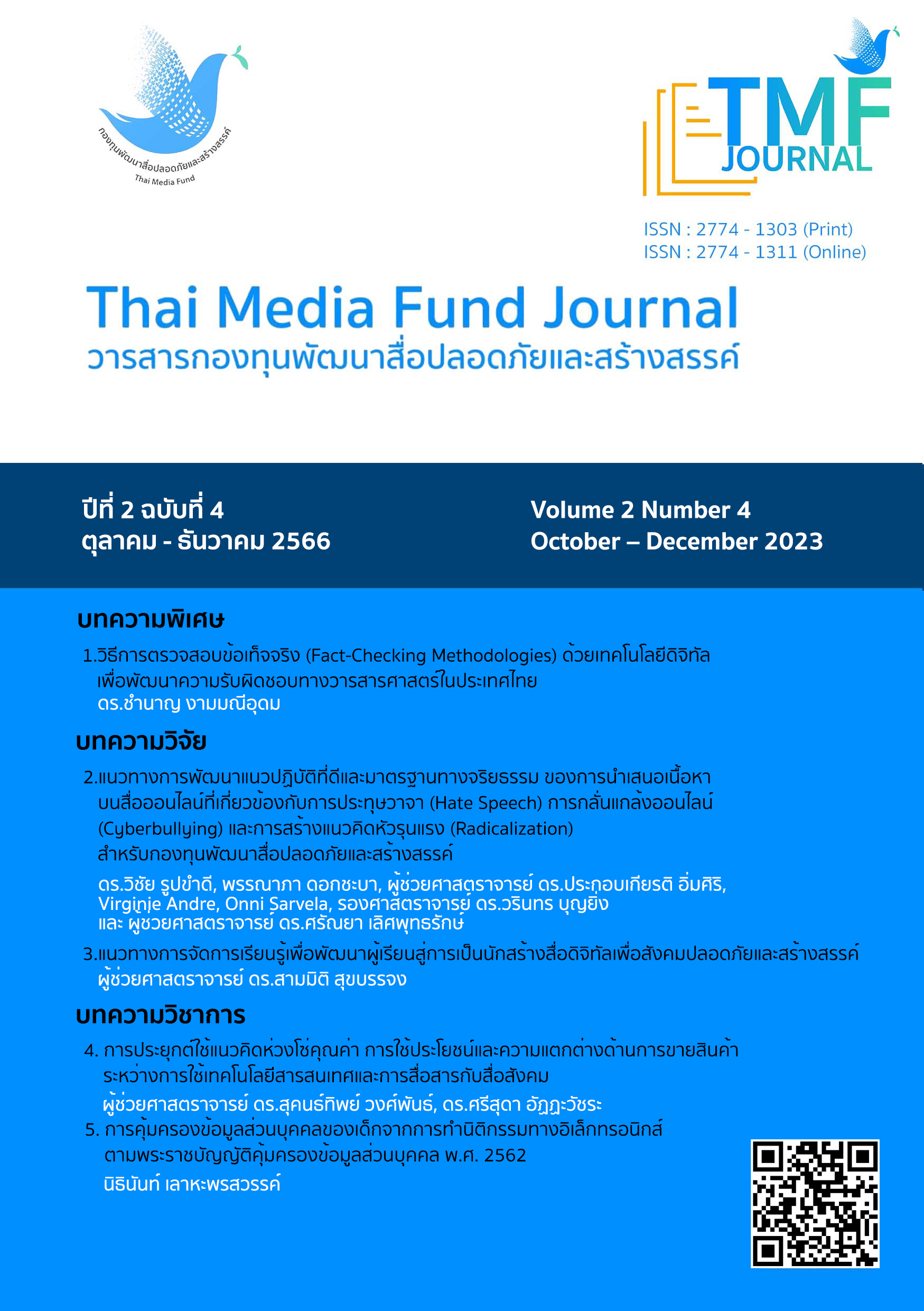แนวทางการพัฒนาแนวปฏิบัติที่ดีและมาตรฐานทางจริยธรรม ของการนำเสนอเนื้อหาบนสื่อออนไลน์ที่เกี่ยวข้องกับการประทุษวาจา (Hate Speech) การกลั่นแกล้งออนไลน์ (Cyberbullying) และการสร้างแนวคิดหัวรุนแรง (Radicalization) สำหรับกองทุนพัฒนาสื่อปลอดภัยและสร้างสรรค์ -
Main Article Content
บทคัดย่อ
งานวิจัยนี้มีวัตถุประสงค์เพื่อศึกษาสถานการณ์ของการประทุษวาจา (Hate Speech) การกลั่นแกล้งออนไลน์ (Cyberbullying) และการสร้างแนวคิดหัวรุนแรง (Radicalization) ที่ปรากฏบนสื่อออนไลน์ในประเทศไทย เพื่อนำเสนอแนวทางการดำเนินงานในระยะเร่งด่วน ระยะกลาง และระยะยาวในประเทศไทยและบทบาทของกองทุนพัฒนาสื่อปลอดภัยและสร้างสรรค์ในการดำเนินงานเกี่ยวกับแนวปฏิบัติที่ดีและมาตรฐานทางจริยธรรมการประทุษวาจา (Hate Speech) การกลั่นแกล้งออนไลน์ (Cyberbullying) และการสร้างแนวคิดหัวรุนแรง (Radicalization) ที่ปรากฏบนสื่อออนไลน์ ใช้การวิจัยเชิงคุณภาพโดยการประชุมกลุ่ม (Focus group) ทางออนไลน์ในการเก็บข้อมูลจากผู้เข้าร่วมการประชุมทั้งหมด 20 กลุ่ม รวมทั้งสิ้น 300 คน ผลการวิจัยพบว่า ปัญหาที่เกิดขึ้นประกอบด้วย การเผยแพร่ภาพลามกอนาจาร การใช้ข้อความและภาพที่ไม่เหมาะสม กับสถาบันพระมหากษัตริย์ การนำความพิการ หรือความบกพร่องทางร่างกายมาล้อเลียน ประเด็นทางด้านการเมือง สาเหตุปัจจัยสำคัญ ประกอบด้วย ความสามารถในการผลิตและเข้าถึงเนื้อหาผ่านสื่อสังคมออนไลน์ได้โดยง่าย การขาดจิตสำนึกของบุคคลทำให้การเลือกใช้สื่อ ภาพ ถ้อยคำ หรือข้อความต่าง ๆ ไม่มีความเหมาะสม โดยเฉพาะการมุ่งผลประโยชน์ในเชิงพาณิชย์ แพลตฟอร์ม/สื่อออนไลน์ที่พบ ประกอบด้วย Facebook Twitter TikTok Instagram YouTube Clubhouse และเว็บเพจต่าง ๆ การกระทำที่เกิดขึ้นผลกระทบทางลบทำให้บุคคลอื่นได้รับความเสียหายด้านชื่อเสียง เกียรติยศ ที่อาจส่งผลกระทบในวงกว้าง ทั้งต่อบุคคล สังคม วัฒนธรรม และประเทศชาติ
Article Details

อนุญาตภายใต้เงื่อนไข Creative Commons Attribution-NonCommercial-NoDerivatives 4.0 International License.
เอกสารอ้างอิง
Abuse Counseling and Treatment, Inc. (2023). Social-ecological model of violence. Retrieved from https://actabuse.com/services/community-education/prevention/social-ecological-model-1024x520/
Bangkok Media and Broadcasting Company Limited. (2021). How to deal with bullying problems that should not be viewed as normal. Retrieved from https://www.pptvhd36.com/health/how-to/4088
British Institute of Human Rights (2012) Mapping study on projects against hate speech online. Retrieved from https://rm.coe.int/16807023b4mk
Cramer, J. R., Fording, R. C., Gerstenfeld, P., Kehn, A., Marsden, J., Deitle, C., King, A., Smart, S., & Nobles, M. R. (2020). Hate-motivated behavior: Impacts, risk factors, and interventions. Retrieved from https://www.healthaffairs.org/do/10.1377/ hpb20200929.601434/
Duangthai, T., & Promsit, S. (2019). Mayhem in the cyber world. Journal of Management Science Nakhon Ratchasima Rajabhat University, 1(1), 1-15.
Henares-Montiel, J., Benítez-Hidalgo, V., Ruiz-Pérez, I., Pastor-Moreno, G., & Rodríguez-Barranco, M. (2022). Cyberbullying and associated factors in member countries of the European Union: A systematic review and meta-analysis of studies with representative population samples. International Journal of Environmental Research and Public Health, 19, 1-13.
Isra News Agency. (2021). Ranked top in Asia! Nearly half of Thai children believe that "bullying" is typical, and over 80% of them have experienced it. Retrieved from https://www.isranews.org/article/isranews-article/105059-isranews-bullying.html
Israel, B. A., Checkoway, B., Schulz, A., & Zimmerman, M. (1994). Health education and community empowerment: Conceptualizing and measuring perceptions of individual, organizational, and community control. Health Education Quarterly, 21(2), 149-170.
Kokiatpitak, K., & Thepwan, N. (2021). Violent extremism. Security Perspective Journal, 6 (February-May). Retrieved from https://www.nsc.go.th/wp-content/uploads/Journal/article-00605.pdf
Komchadluek. (2023). The bullying situation in Thailand is severe. The online crisis makes the marks of bullying last longer. Retrieved from https://www.komchadluek.net/quality-life/well-being/540559
Krueger, R. A. (1998). Moderating focus groups, focus group kit. Thousand Oaks: Sage.
Krueger, R. A., & Casey, M. A. (2000). Focus groups: A practical guide for applied research. Thousand Oaks, California: Sage.
National Statistical Office. (2021). Survey of technology use. Household information and communication 2021 (2nd quarter). Retrieved from http://www.nso.go.th/sites/2014/DocLib13/%E0%B8%94%E0%B9%89%E0%B8%B2% E0% %AD%E0%B8%99/2564/report_64.pdf
Oguz, A., Mehta, N., & Palvia, P. (2023). Cyberbullying in the workplace: A novel framework of routine activities and organizational control. Internet research, In print.
Phattharathamrong, P. (2016). Exposure to and opinions on hate speech content among online media receivers: A case study of Facebook fan page. “Stop prettifying Thailand”. Thammasat University.
Phianjad, D., Sinthaworn, W., & Kosila, J. (2020). Promoting awareness about cyberbullying and verbal abuse of students at the basic education level: A case study schools in Chachoengsao province. Rajabhat Rajanagarindra University, Chachoengsao.
Prince, M., & Davies, M. (2001). Moderator teams: An extension to focus group methodology. Qualitative Market Research: An International Journal, 4(4), 207-216.
Prevent Connect. (2023). Socio-ecological model. Retrieved from https://wiki.preventconnect.org/socio-ecological-model/
Ramasutta, P. (2015). Conflict of speech and the online world. Bangkok: Foundation for Education Democracy and development (Torch Publishing Project).
Ritchie, J., & Spencer, L. (2002). Qualitative data analysis for applied policy research. In Huberman, M.A. & Miles, M.B. (eds). The Qualitative Research Companion. London: Sage Publications, 305-329.
Statista. (2023). Cyber bullying-statistics & facts. Retrieved from https://www.statista.com/topics/1809/cyber-bullying/#topicOverview
Stewart, D. W., & Shamdasani, P. N. (1990). Focus groups: Theory and practice. Thousand Oaks. California: Sage.
Surat, P. (2018). Causes and consequences related to bullying through the cyber world: A case study of Thai youth who were bullied. Retrieved from
Thai Health Promotion Foundation. (2020). Communication that creates hate (Hate speech). Retrieved from http://cclickthailand.com/wp-content/uploads/2020/04/hate_speech_FINAL.pdf
The United Nations Development Programme (UNDP). (2022). Guidance note from pilots to practice: Risk-informed utilization of online data for preventing violent extremism and addressing hate speech. Retrieved from https://www.undp.org/sites/g/files/zskgke326/files/2022-05/UNDP-Guidance-Note-Risk-Informed-Utilization-of-Online-Data-for-PVE-and-Addressing-Hate-Speech.pdf


